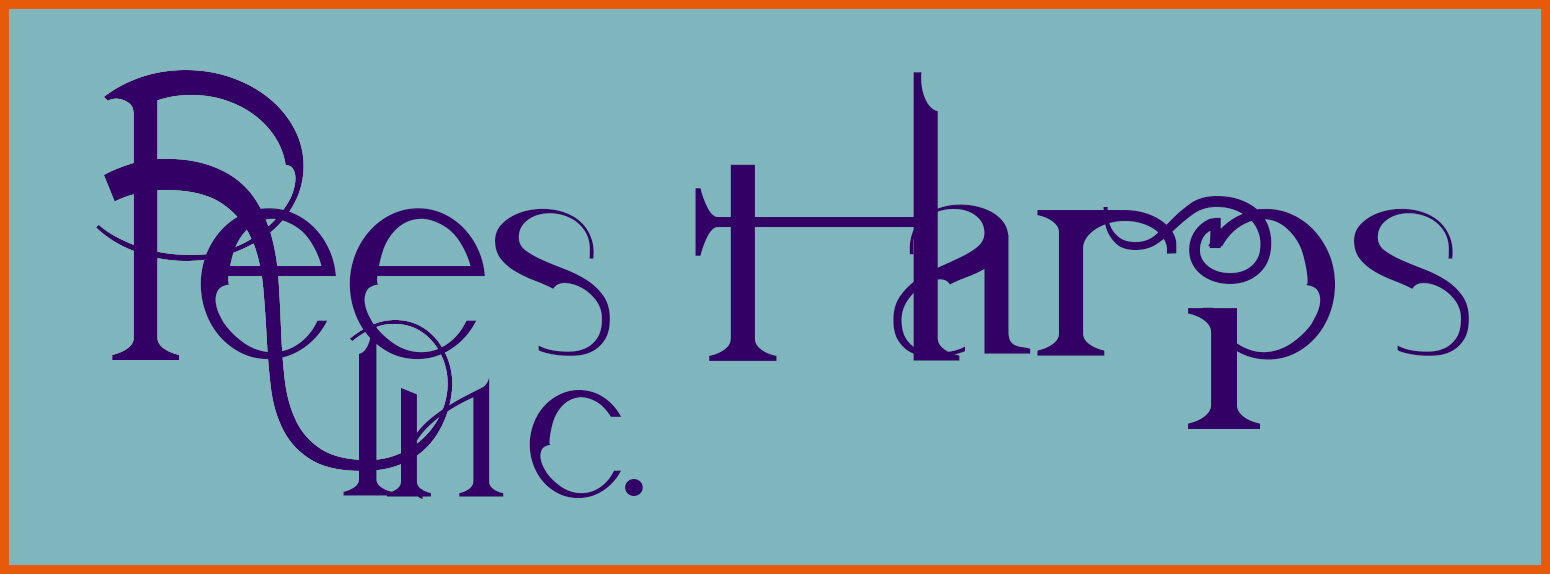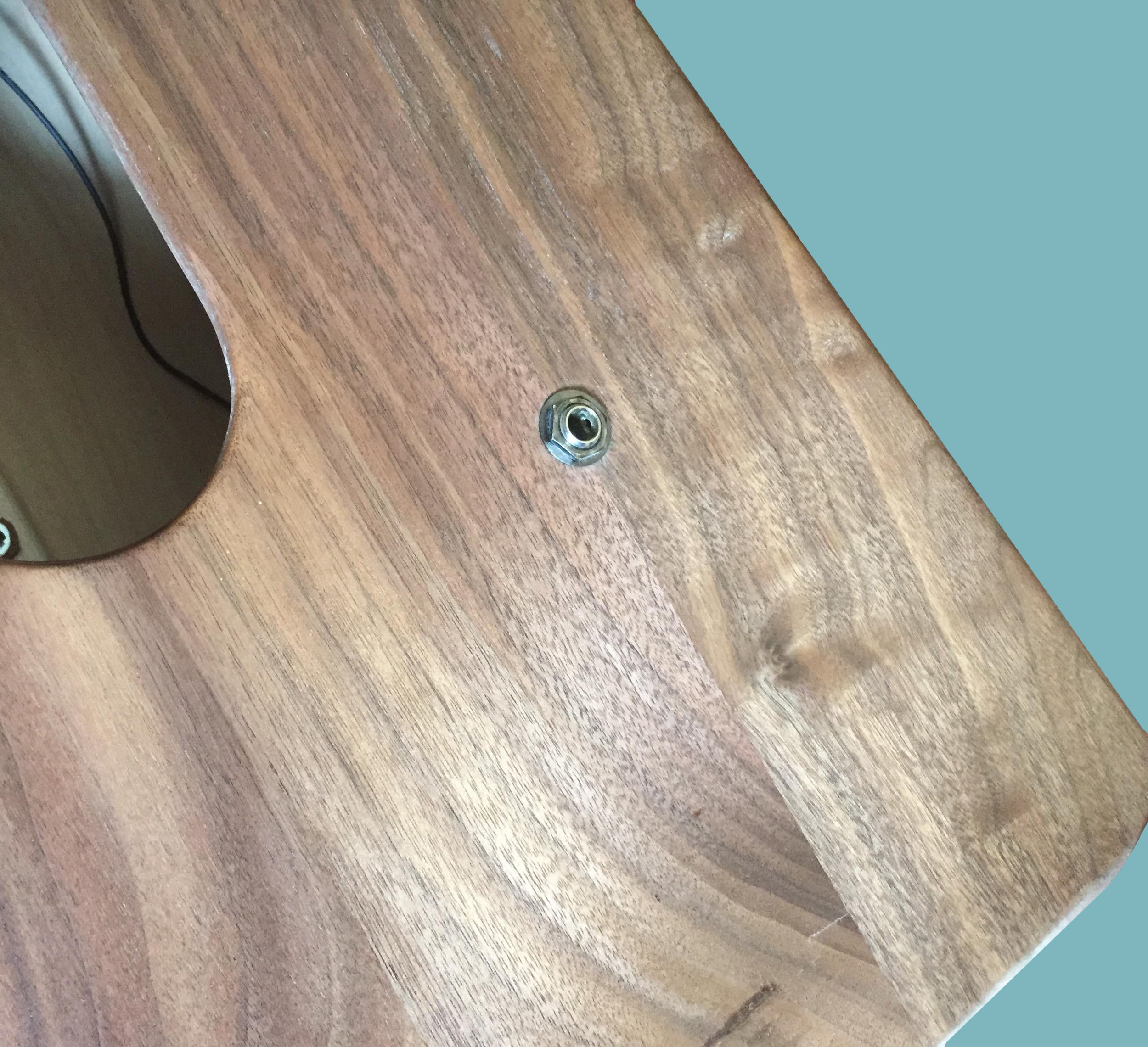Amplifying Your Harp
Many times you may be in a situation where your performance needs to be amplified to be heard. Today it is easier than ever to amplify your harp and get a good reproduction of the sound of your instrument. You can decide to have a very simple set-up, appropriate for many performance environments, or a more complex set-up which will allow you the greatest amount of flexibility.
Definitions (in order of use)
Pickup - A device (piezo, transducer, microphone etc.) attached directly to your harp so that it picks up the sound most effectively.
Jack - the metallic hole on the side or back of the harp. The jack is sometimes called a "1/4 inch jack."
Cable - a cord that carries an electrical signal.
Preamp - can be either internal or external. Takes the entire existing signal from the pickup and makes it louder. Some preamps do this uniformly and some have built-in equalizers.
Equalizer - a piece of equipment, ranging from tiny to quite large, which has sliders that allow the different sections of a signal (high, midrange and low) to be individually identified and adjusted in volume. An equalizer is commonly called an "EQ."
Compressor - in a noisy environment, when you have your preamp and amplifier turned up, a compressor will automatically clip off any high brittle sounds or low rumbly wolf tones which sometimes come from over-amplification of a harp.
Amplifier - a box containing electrical circuitry (volume, tone) and speakers. An amplifier makes the incoming sound much louder and sends it out, through speakers, to your audience. An amplifier is commonly called an "amp."
Putting It All Together
In a simple amplification set-up, the pickup is attached to your harp and it is connected, with wires, to the jack. The cable plugs into the jack on one end and the amp on the other. Always plug everything together with the amplifier off or with the volume set to zero.
In a more complex amplification set-up the pickup is attached to the jack. A cable connects the jack to the pre-amp/EQ which is connected, also by cable, to a compressor and, from the compressor to amp runs yet another cable which completes your set-up. (See below for some things you may not know about "Cables.")
Cables
Cables connect everything to everything else and yet this critical component is ignored by most musicians. A quality cable is very important and you can easily hear the difference between a high definition cable and an economy cable. Buying an economy cable is like settling for a terrible Wifi signal. Having a fast computer doesn't matter if the WiFi is slow. If you have a quality harp and pickup system you want to make sure that your amp gets to hear that quality and pass it on to your audience. We recommend and carry the famous Asterope cables which are widely acknowledged to be the best in the industry.
Rees Pro Pickup
Our Rees Pro Pickup combines a pickup, preamp, automatic adjusting EQ and Compressor into a single system which is internally mounted in the harp. ...because you have enough to worry about on performance days.
Pickups vs Microphones
A microphone will give you the best sound production if you (1) purchase the highest quality mic, (2) have it operated by an experienced sound technician who is specifically experienced with harp amplification and (3) the sound technician is operating a good quality mixer. If you don't have someone like that following you around then forget the microphone for your harp. Even if you try to set-up a mic yourself, in advance, you are inviting feedback squeals, exterior room noises and generally poor amplification. You want to have the sound for your harp under your control.
Pickups today are generally very good and will give consistent results. Less expensive pickups (usually round disc types) will tend to be somewhat bright in tone. More expensive pickups (usually rectangular) will produce warmer fuller tone. Having the pickup located in the proper location on the harp will also make a big difference (see below). Through decades of amplifying thousands of harps we have found that a single pickup, located correctly will give a balanced sound to the harp which is similar to what your ear hears in a quiet room. We have found multiple pickups to require significantly more adjustment because they overbalance the high and the midrange. If you are purchasing a Rees Harp, we recommend the Rees Pro Pickup, available both installed and separately.
Pickup Location
First, let's discuss frequencies and the sensitivity of the human ear. Humans hear high frequencies better than low frequencies. In a band situation the lead guitar player can get by with a 100 watt amplifier but the bass player needs a 250 watt amp just to "stay even." Since the human ear can't hear bass frequencies as well, the bass needs to have much more amplification than the guitar player in order to sound balanced to the audience. A pedal harpist will notice that when playing the lowest octave on their harp those strings are barely audible compared to the other octaves. Again, those lower octaves are harder for the human to hear. Another interesting fact, if the harpist could play two and a half steps lower than the pedal harp actually extends, the human ear could not distinguish if that note is out of tune, sharp or flat, in most cases. We simply lose the ability to distinguish pitch!
Harps made with pickups on every string or a series of pickups up the soundboard treat all the strings the same but, as we have revealed, the ear doesn't hear it that way. So, for these harps, volume controls and EQs are a necessity in order to make adjustments. At Rees Harps we both design our harps and place our pickups with the biological realities of the human ear in mind. For amplification, we use a single pickup strategically placed. This is not something new we just stumbled across. Having built thousands of harps over nearly fifty years we have brought an enormous amount of experience to bear and have found an optimal solution.
We place a single pickup half way between the last octave of the harp and half way from the midrib (where the strings are attached) and the side of the harp. It is a simple formula but it works wonderfully. This allows for a strong bass response, which the human ear needs, and then graduates evenly up the soundboard with no problem picking up the highs that vibrate throughout the soundboard and ultimately producing a balanced volume. It is also easy to make minor EQ adjustments, if needed, because one only needs to adjust the highs or lows instead of dealing with troublesome midranges which sound techs can tell you requires an art in itself. It works and it is simple.
Preamps
Our recommended pick-up has a preamp built in. A preamp is a device that strengthens the signal coming from your harp. It is powered by a battery. This stronger signal will assure that more of the full sound of your harp will ultimately reach the amp. A preamp is not a necessity but it will provide a noticeable improvement in performance. You can have an internal preamp, which is wired inside your harp just before the jack, or you can purchase an external preamp that rests on the floor. To simplifiy things, we generally recommend that you purchase a preamp that has an equalizer built in. Connect the preamp/EQ to your harp with a short cable (3 ft/.9m or less). A short cable loses less signal and you get better results.
With all preamps it is very important to unplug the preamp when you are not using it. If you do not the battery will continue to drain.
Equalizer
You may have seen an EQ (equalizer) on standard home stereo equipment. An equalizer has several slider knobs in a row. These sliders adjust the volume of the bass, midrange and treble frequencies. If you want more bass then move the bass sliders up a little. If the sound is to bright then you would move the treble sliders down a little. The biggest mistake amateurs make is moving the sliders to the extremes. On any EQ start with the sliders all even in the middle. If the harp sounds fine leave the EQ alone. If the instrument voice is too bright then lower the treble sliders a little. You can experiment with the different frequencies toto get a sense for what they do. Every instrument will be different and every room will reflect sound back differently. An empty room will, for instance, sound very different than that same room sounds when it is full of people. If you're not getting the sound that you want, go back to neutral and start again. Adjust in tiny amounts and you will find that sweet spot.
Compressor
Another electronic floor box you may consider is a compressor. A compressor is useful when working in noisy rooms or when you have to increase your volume considerably in order to be heard. Like a preamp, a compressor runs on a battery. When you are using one it will automatically clip off any high brittle sounds and low wolf tones thereby keeping your sound as clean as reasonably possible. Also like a preamp, a compressor should be plugged in as close to your preamp/EQ as possible. There are short connector cables available made just for this purpose.
Sometimes, it really is the simple things. For instance, do not perform with your amp (or any amp) behind you. The loud noise coming from the amp will interfere with the vibrations of your harp and also with the pickup. Place the amp several feet to the side but slightly tilted toward you so you can hear yourself. (If you have a separate monitor speaker then the amp should go straight forward.) Also, the higher off the ground your amp is located, like on a solid box or stool or, better yet, an amp stand, the easier the sound will travel through a crowded room requiring less amplified volume. If it is a really crowded reception room, pointing the speakers at an angle toward the ceiling will allow the ceiling to ricochet the sound across the room. In those instances, every little bit can be helpful!
Another important thing to know about amps is that not all amplifiers are created equal when it comes to harps. most are made to optimize guitars, basses or electronic keyboards. Some of these are really wonderful with harps and some are just awful. We carry a number of amps we feel we can confidently recommend but there are others out there, just be sure to try them with your harp first.






